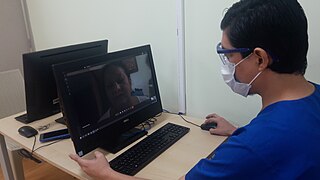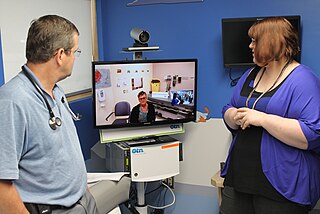Related Research Articles

The Health Insurance Portability and Accountability Act of 1996 is a United States Act of Congress enacted by the 104th United States Congress and signed into law by President Bill Clinton on August 21, 1996. It aimed to alter the transfer of healthcare information, stipulated the guidelines by which personally identifiable information maintained by the healthcare and healthcare insurance industries should be protected from fraud and theft, and addressed some limitations on healthcare insurance coverage. It generally prohibits healthcare providers and businesses called covered entities from disclosing protected information to anyone other than a patient and the patient's authorized representatives without their consent. The bill does not restrict patients from receiving information about themselves. Furthermore, it does not prohibit patients from voluntarily sharing their health information however they choose, nor does it require confidentiality where a patient discloses medical information to family members, friends or other individuals not employees of a covered entity.

Telehealth is the distribution of health-related services and information via electronic information and telecommunication technologies. It allows long-distance patient and clinician contact, care, advice, reminders, education, intervention, monitoring, and remote admissions. Telemedicine is sometimes used as a synonym, or is used in a more limited sense to describe remote clinical services, such as diagnosis and monitoring. When rural settings, lack of transport, a lack of mobility, conditions due to outbreaks, epidemics or pandemics, decreased funding, or a lack of staff restrict access to care, telehealth may bridge the gap as well as provide distance-learning; meetings, supervision, and presentations between practitioners; online information and health data management and healthcare system integration. Telehealth could include two clinicians discussing a case over video conference; a robotic surgery occurring through remote access; physical therapy done via digital monitoring instruments, live feed and application combinations; tests being forwarded between facilities for interpretation by a higher specialist; home monitoring through continuous sending of patient health data; client to practitioner online conference; or even videophone interpretation during a consult.

Telenursing refers to the use of information technology in the provision of nursing services whenever physical distance exists between patient and nurse, or between any number of nurses. As a field, it is part of telemedicine, and has many points of contacts with other medical and non-medical applications, such as telediagnosis, teleconsultation, and telemonitoring. The field, however, is still being developed as the information on telenursing isn't comprehensive enough.

Telepsychiatry or telemental health refers to the use of telecommunications technology to deliver psychiatric care remotely for people with mental health conditions. It is a branch of telemedicine.
Home automation for the elderly and disabled focuses on making it possible for older adults and people with disabilities to remain at home, safe and comfortable. Home automation is becoming a viable option for older adults and people with disabilities who would prefer to stay in the comfort of their homes rather than move to a healthcare facility. This field uses much of the same technology and equipment as home automation for security, entertainment, and energy conservation but tailors it towards old people and people with disabilities.
Connected health is a socio-technical model for healthcare management and delivery by using technology to provide healthcare services remotely. Connected health, also known as technology enabled care (TEC) aims to maximize healthcare resources and provide increased, flexible opportunities for consumers to engage with clinicians and better self-manage their care. It uses readily available consumer technologies to deliver patient care outside of the hospital or doctor's office. Connected health encompasses programs in telehealth, remote care, and disease and lifestyle management. It often leverages existing technologies, such as connected devices using cellular networks, and is associated with efforts to improve chronic care. However, there is an increasing blur between software capabilities and healthcare needs whereby technologists are now providing the solutions to support consumer wellness and provide the connectivity between patient data, information and decisions. This calls for new techniques to guide Connected Health solutions such as "design thinking" to support software developers in clearly identifying healthcare requirements, and extend and enrich traditional software requirements gathering techniques.

Zocdoc is a New York City-based company offering an online service that allows people to find and book in-person or telemedicine appointments for medical or dental care. The platform also functions as a physician and dentist rating and comparison database. The service is free for patients, and doctors pay to advertise their appointment slots. Established in 2007, the private company had a $1.8 billion valuation by August 2015, the third-highest for a startup in New York at the time.

Remote patient monitoring (RPM) is a technology to enable monitoring of patients outside of conventional clinical settings, such as in the home or in a remote area, which may increase access to care and decrease healthcare delivery costs. RPM involves the constant remote care of patients by their physicians, often to track physical symptoms, chronic conditions, or post-hospitalization rehab.
Digital health is a discipline that includes digital care programs, technologies with health, healthcare, living, and society to enhance the efficiency of healthcare delivery and to make medicine more personalized and precise. It uses information and communication technologies to facilitate understanding of health problems and challenges faced by people receiving medical treatment and social prescribing in more personalised and precise ways. The definitions of digital health and its remits overlap in many ways with those of health and medical informatics.
Healthcare CRM, also known as Healthcare Relationship Management, is a broadly used term for a Customer relationship management system, or CRM, used in healthcare.

Medical image sharing is the electronic exchange of medical images between hospitals, physicians and patients. Rather than using traditional media, such as a CD or DVD, and either shipping it out or having patients carry it with them, technology now allows for the sharing of these images using the cloud. The primary format for images is DICOM. Typically, non-image data such as reports may be attached in standard formats like PDF during the sending process. Additionally, there are standards in the industry, such as IHE Cross Enterprise Document Sharing for Imaging (XDS-I), for managing the sharing of documents between healthcare enterprises. A typical architecture involved in setup is a locally installed server, which sits behind the firewall, allowing secure transmissions with outside facilities. In 2009, the Radiological Society of North America launched the "Image Share" project, with the goal of giving patients control of their imaging histories by allowing them to manage these records as they would online banking or shopping.
American Well Corporation, doing business as Amwell, is a telemedicine company based in Boston, Massachusetts, that connects patients with doctors over secure video. Amwell sells its platform as a subscription service to healthcare providers to put their medical professionals online and its proprietary software development kits, APIs, and system integrations enable clients to embed telehealth into existing workflows utilized by providers and patients.

Glooko, Inc provides a Software-as-a-Service (SaaS) application and accompanying mobile app for diabetes patients and their healthcare providers in the United States and internationally.
Teladoc Health, Inc. is a multinational telemedicine and virtual healthcare company headquartered in the United States. Primary services include telehealth, medical opinions, AI and analytics, telehealth devices and licensable platform services. In particular, Teladoc Health uses telephone and videoconferencing software as well as mobile apps to provide on-demand remote medical care.
Mental health informatics is a branch of health or clinical informatics focused on the use of information technology (IT) and information to improve mental health. Like health informatics, mental health informatics is a multidisciplinary field that promotes care delivery, research and education as well as the technology and methodologies required to implement it.
e-consult is a mechanism developed by the Department of Veterans Affairs that enables primary care providers to obtain specialists' inputs into a patient's care treatment without requiring the patient to go to a face-to-face visit.
This list of telemedicine services providers is for notable telemedicine, telehealth, and mobile health providers and services. This includes virtual care facilities for remote care, services or platforms used for specific steps within the healthcare industry, and clinical navigation.

Carbon Health is an American chain of primary healthcare and urgent care clinics that also provides telemedicine. It was founded in 2015 in San Francisco.

Before the COVID-19 pandemic, telehealth adoption was gradually increasing. With the outbreak of COVID-19 in early 2020, healthcare professionals reduced in-person visits to minimize exposure. This led to an increase in the use of telemedicine. with a concomitant increase in publications.. Telehealth has since remained widely utilized in healthcare services.
Vetster Inc. is a Canadian veterinary telemedicine company. It is headquartered in Toronto, Canada.
References
- ↑ Agnisarman, Sruthy Orozhiyathumana; Chalil Madathil, Kapil; Smith, Kevin; Ashok, Aparna; Welch, Brandon; McElligott, James T. (January 2017). "Lessons learned from the usability assessment of home-based telemedicine systems". Applied Ergonomics. 58: 424–434. doi:10.1016/j.apergo.2016.08.003. ISSN 1872-9126. PMID 27633239.
- ↑ "Spotlight Interview: Brandon Welch, MS, PhD, Founder & CEO, Doxy.me – Medical Travel & Digital Health News". 2024-04-23. Retrieved 2024-08-30.
- ↑ "U Telehealth Startup Doxy.me Booms During Pandemic". lassonde.utah.edu.
- ↑ Norton, Jerry (2014-04-16). "One tasty entry: Cowboy Kolaches wins Utah Entrepreneur Challenge 2014". The David Eccles School of Business. Retrieved 2024-08-30.
- ↑ "Doxy.me Turning Risk into Reward". lassonde.utah.edu.
- ↑ "Telemedicine 'adoption curve changed overnight' Doxy.me added thousands of providers". Yahoo Finance. 2020-05-01. Retrieved 2024-08-30.
- ↑ Alsever, Jennifer (2021-05-18). "These telehealth startups became global powerhouses overnight". Utah Business. Retrieved 2024-08-30.
- ↑ "Geared for Growth: Doxy.me Connecting Providers and Patients Through Telehealth Solutions". Greater Rochester Chamber of Commerce. 2024-03-13. Retrieved 2024-08-30.
- ↑ "About Us". Doxy.me. Retrieved 2024-08-30.
- ↑ Alsever, Jennifer (2021-05-18). "These telehealth startups became global powerhouses overnight". Utah Business. Retrieved 2024-08-30.
- ↑ Welch, Brandon. "Council Post: Focus On The Features That Make Your Product Uniquely Useful". Forbes. Retrieved 2024-08-30.
- ↑ Post; Share; Post; Print; Email; License. "Providers scramble for telehealth, pick Microsoft, Zoom and doxy.me in pandemic's early days". Healthcare Dive. Retrieved 2024-08-30.
{{cite web}}:|last5=has generic name (help) - ↑ "KLAS: Teladoc, Epic report widest breadth of telehealth capabilities". Healthcare IT News. 2021-05-21. Retrieved 2024-08-30.
- ↑ Welch, Brandon M.; Marshall, Elizabeth; Qanungo, Suparna; Aziz, Ayesha; Laken, Marilyn; Lenert, Leslie; Obeid, Jihad (2016-03-31). "Teleconsent: A novel approach to obtain informed consent for research". Contemporary Clinical Trials Communications. 3: 74–79. doi:10.1016/j.conctc.2016.03.002. ISSN 2451-8654. PMC 5096381 . PMID 27822565.
- ↑ "RePORT ⟩ RePORTER". reporter.nih.gov. Retrieved 2024-08-30.
- ↑ "At Doxy.me, simplicity is key to telehealth security". Healthcare IT News. 2020-06-01. Retrieved 2024-08-30.
- ↑ "Privacy Not Included". foundation.mozilla.org.
- ↑ Winsa, Patty (2024-03-18). "Could your health data be stored on U.S. servers? Lawsuit tests Ontario's privacy safeguards". Toronto Star. Retrieved 2024-08-30.
- ↑ Cummins, Mollie R.; Shishupal, Sukrut; Wong, Bob; Wan, Neng; Han, Jiuying; Johnny, Jace D.; Mhatre-Owens, Amy; Gouripeddi, Ramkiran; Ivanova, Julia; Ong, Triton; Soni, Hiral; Barrera, Janelle; Wilczewski, Hattie; Welch, Brandon M.; Bunnell, Brian E. (2024-05-15). "Travel Distance Between Participants in US Telemedicine Sessions With Estimates of Emissions Savings: Observational Study". Journal of Medical Internet Research. 26: e53437. doi: 10.2196/53437 . ISSN 1438-8871. PMC 11137427 . PMID 38536065.